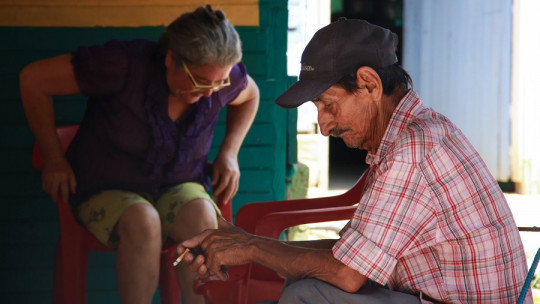From psychology, communication is understood as an essential tool to know others, understand the world and express our thoughts. Verbal language is the main means of communication (although not the only one). Therefore, when it presents some type of alteration, the person’s life can be affected.
Logoclony is a language alteration in which the syllable in the middle or end of words is repeated. It appears associated with some pathologies such as Alzheimer’s dementia, Parkinson’s or Kluver-Bucy Syndrome. In this article we will know it in detail.
Logoclony: characteristics
Logoclony is the spasmodic, compulsive, multiple repetition of a syllable in the middle or at the end of a word (for example: “I want to go to the supermarket, do, do, do.”). Sometimes it can also directly include words (“on Saturday I’m going to the movies, movies, movies, do you want to come?”).
Logoclony is manifested by the patient in a completely involuntary and dystonic manner (dystonia involves sustained muscle contractions in one or more parts of the body).
Consists in an alteration of verbal (oral) language, and indicates organicity (organic origin of a disease), as well as other disorders such as palilalia. It is usually associated with Alzheimer’s dementia, among others.
The verbal language
Verbal language is the main means of human communication, and the main resource in teaching-learning processes. It allows us to communicate with others, exchange information, express what we think, desire, opinion, etc.
In short, it is a tool that enables and enhances social relationships, although It is not the only type of language in communication (non-verbal language is also essential, and complements verbal language).
In psychology, verbal language is explored in the context of a clinical interview, through observation and detailed analysis of what the patient communicates spontaneously and his or her oral responses to the psychologist’s questions.
To evaluate verbal language disorders, different aspects of the patient’s verbal expression will be analyzed (tone, intensity, vocalization, coherence…). In the case of logoclony, this is easy to verify when the patient repeats the middle or final syllables of the words in his speech.
Symptoms such as language disorder
The fact that alterations or disorders appear in verbal language entails a series of consequences in the life of the person who suffers from them, at a relational, personal, work level, etc. Psychologically the person may be affected, and end up avoiding social situations or conversations out of embarrassment, for example. This is especially seen in dysphemia (stuttering).
Logoclony is one of these disorders that we mentioned, and it can cause suffering or discomfort in the patient, although depending on the pathology associated with logoclony (for example Parkinson’s, Alzheimer’s,…), its meaning for the person and/or interference in your life it will be different (also depending on your awareness of illness or degree of contact with reality, for example).
Thus, logoclony is part of the speech language disorders, specifically the group of iterative disorders or verbal stereotypies This group of disorders involves frequent and abnormal repetition of a syllable, word or phrase. In the case of logoclony, these are syllables and words.
Likewise, logoclony is a language disorder that affects its rhythm and course.
Causes and associated pathologies
The logoclony manifests itself in Parkinson’s disease, Alzheimer’s dementia and other conditions, especially in pseudobulbar and senile dementias. It can also appear in Kluver Bucy Syndrome, a behavioral disorder caused by the involvement of the bilateral temporal lobes.
Pseudobulbar affection
As we have seen, one of the pathologies where logoclony appears is pseudobulbar involvement. Pseudobulbar affection (PSA), also called emotional lability, is a condition characterized by the presence of exaggerated or inappropriate emotional expression in relation to the context and that typically involves episodes of laughter and crying.
This painting is associated with neurological disorders involving brain damage such as cerebrovascular accident (CVA), traumatic brain injury, multiple sclerosis (MS), amyotrophic lateral sclerosis (ALS), Alzheimer’s disease and Parkinson’s disease.
Example
An example of logoclony would be the following phrase: “When I walk, I always wander, I walk, all words have I walk, therefore I want to keep walking, I walk.”
In this case, two syllables of the same word /“an”/-/”do”/ are repeated.
Other language disorders
Logoclony, as we have seen, is a speech language disorder that is included within the group of iterative disorders or verbal stereotypies. In turn, other alterations are included within this group, such as:
1. Echolalia
Consists in the involuntary repetition of a word or phrase that has just been heard or has just been pronounced. It frequently appears in Autism Spectrum Disorders).
2. Palilalia
Similar to logoclony, although it is not exactly the same. It consists of the involuntary, spontaneous and monotonous repetition of the same phrase, word or syllable
3. Verbigeration
It is the automatic emission of words or entire phrases, incoherent and without continuity It is common in dementia states.
4. Coprolalia
It consists of the pathological tendency to utter obscenities (it is common in Tourette’s Disorder). This tendency circumscribes all words and phrases considered culturally “taboo” or inappropriate in the social sphere.
Treatment
In addition to psychological therapy, treatment from a medical perspective depends on the type of brain injury behind the logoclony.










